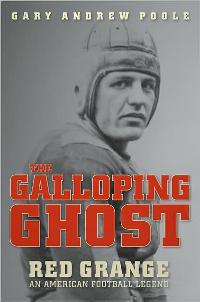In the new book, The Galloping Ghost, author Gary Andrew Poole explores the life and career of Red Grange, the man who is single-handedly credited with bringing professional football out of obscurity and into the national consciousness in the 1920´s.
 In
1923, his first season of playing college football, Grange
and his teammates at the University of Illinois went
undefeated with a perfect 8-0 record. Grange had 12
touchdowns and rushed for 1,260 yards that year. Illinois
shared the 1923 college football national championship with
the University of Michigan.
In
1923, his first season of playing college football, Grange
and his teammates at the University of Illinois went
undefeated with a perfect 8-0 record. Grange had 12
touchdowns and rushed for 1,260 yards that year. Illinois
shared the 1923 college football national championship with
the University of Michigan.On October 18, 1924, in the third game of his second college football season, Illinois hosted Michigan in what was billed as the matchup of the year. Coming into the game, Michigan had a 27-game winning streak that dated back to 1921.Grange cemented his place in college football history that day by scoring four touchdowns in the first 12 minutes of the game. He took the opening kickoff and returned it 95 yards for a touchdown. On the next series, Grange had a 67-yard touchdown run. The third time he touched the ball, Grange ran 56 yards for another touchdown and his fourth touchdown came on a 44-yard run. The Illini went on to win the game 39-14. It was the first game ever played at Illinois´ newly built Memorial Stadium in Champagne, where the team still plays today.
In all, Grange scored five rushing touchdowns against Michigan, threw a touchdown pass, returned a kickoff for a touchdown and intercepted two passed while playing defense. He had 212 yards rushing, 64 yards passing and 126 return yards for a total of 402 yards on the day.
Grange may have been known as the Galloping Ghost, but he was also known by another nickname, The Wheaton Iceman. During the summers, Grange worked a job delivering ice to people in his hometown of Wheaton, Illinois. He had about 40 customers on his route and worked six days a week. Delivering 50-pound blocks of ice in the summer kept him in shape for playing football in the fall.
While Grange was in college, he became friends with Charles C. Pyle, an entrepreneur/con-man who, at the time, was the manager of the local movie house. C.C. Pyle, as he was known, saw the potential in marketing Grange and knew that he could be a great star at the professional football level. Pyle talked Grange into secretly becoming his partner.
While Grange played football for Illinois during his senior season in 1925, Pyle was quietly shopping the college superstar's services to the Chicago Bears. The NFL was only five years old at the time and needed a big name player if it hoped to survive. Pyle met with the Bears owner/player George Halas as the college football season was getting underway. Halas had also gone to college at Illinois and even played football under the same coach that Grange was now playing for, Robert Zuppke.
Pyle secretly negotiated a deal that would have Grange join the Bears as soon as the Illinois football season was over. Once he was signed with the Bears, the team would embark on a barnstorming tour across the country to show off their newest player. Pyle was also the one who went out and secured opponents for the Bears barnstorming tour. In return, Grange and Pyle would receive 50% of the money generated from the tour.
After shocking the college football world in the game against Michigan in 1924, Grange and his Illinois team struggled during the first part of the 1925 season. Illinois was 1-3 going into the game against the heavily favored University of Pennsylvania Quakers and Grange's performance so far that season had been average at best.
The weather in Philadelphia was snowy and cold that day and the field at Franklin Field was a muddy mess. However, the first time Grange touched the ball he ran 56 yards for a touchdown. Grange finished the game with 363 yards rushing and Illinois won the game 24-2. It was the first time that the influential sportswriters from the east coast had gotten a first-hand look at Grange in action. Their pregame skepticism of the Illinois running back turned to post game adulation after witnessing his performance.
Grange played his last college football game on November 21, 1925. It was a 14-9 road win at Ohio State in front of a crowd of 84,295. Minutes after the game was over, he announced that he was going to enter pro football.
The very next day, he signed a contract in Chicago to play for the Bears. A few hours after the signing, he was in attendance at the Bears game against the Green Bay Packers, but he did not play. He made his NFL debut a few days later on November 26, Thanksgiving Day, in a game against the Chicago Cardinals. The game ended in a 0-0 tie.
After that, the Bears embarked on an 18-game barnstorming tour with their new star. They played eight games in the next 15 days against teams in New York, Detroit, Boston, Pittsburgh, St. Louis, Philadelphia, Columbus, Ohio and Washington, D.C. The second leg of the tour took them to Tampa, Jacksonville, New Orleans, San Diego, Los Angeles, San Francisco and Portland, Oregon. The final game of the tour was on January 31, 1926 in Seattle, Washington. Grange played in all but two of the 19 total games with the Bears.

